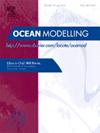2020年夏季分层黄海上层海洋对三个连续热带气旋的响应
IF 2.9
3区 地球科学
Q2 METEOROLOGY & ATMOSPHERIC SCIENCES
引用次数: 0
摘要
2020年夏季,三个连续的热带气旋“巴维”、“梅萨克”和“海神”分别以7天和5天的间隔经过黄海。针对这一独特的天气事件,利用数值模拟、卫星观测和现场观测,研究了相应的海温变化及其水动力机制。由于强烈的垂直混合,在每个TC之后,东太平洋海温都出现了显著的降低,其中由于其强度和未受干扰的海洋分层,巴维造成了最强的冷却。随后,尽管天气条件相似,但“梅萨克”造成的地表冷却几乎是“海神”的两倍。在强烈的混合作用下,东太平洋上层海洋盐度普遍增加,这种混合作用盖过了降水的清新作用。通过TC涡去除实验,我们证明了Maysak和hashen之后的低海温主要是由于Bavi留下的冷水带入上层造成的。“梅萨克”引起的地表冷却因“巴维”的前期影响而加剧,而“海神”引起的地表冷却因“巴维”和“梅萨克”的前期影响而减弱。这是由于巴维飓风后海温的快速回升为Maysak创造了一个高的前期海温;然而,重新升温只发生在薄薄的表层,下面的水仍然是冷的。对于海深来说,tc前海温保持较低,混合层较深,尽管强度与Maysak相当,但地表冷却要弱得多。这项研究增强了我们对分层陆架水对连续tc的响应的理解。本文章由计算机程序翻译,如有差异,请以英文原文为准。
Upper ocean responses to three sequential tropical cyclones in the stratified yellow sea during summer 2020
Three sequential tropical cyclones (TCs), Bavi, Maysak, and Haishen, passed over the Yellow Sea (YS) during summer 2020, separated by intervals of seven and five days. Focusing on this unique synoptic event, this study investigated the corresponding sea surface temperatures (SSTs) variations and the underlying hydrodynamic mechanisms using numerical simulations and satellite and in-situ observations. Notable SST decreases occurred in the eastern YS following each TC due to intense vertical mixing, with Bavi causing the strongest cooling due to its intensity and the undisturbed ocean stratification. Subsequently, despite similar weather conditions, Maysak induced almost twice as much surface cooling as Haishen. Upper ocean salinity generally increased in the eastern YS under strong mixing which override the freshening effect of precipitation. By conducting TC vortex removal experiments, we demonstrated that the low SSTs following Maysak and Haishen were primarily due to cold water entrained into the upper layer left by Bavi. Surface cooling caused by Maysak was intensified by Bavi's prior influence, whereas that caused by Haishen was weakened by both Bavi and Maysak's influence. This was because rapid SST rewarming after Bavi created a high pre-TC SST for Maysak; however, rewarming only occurred in the thin surface layer, leaving the water below still cold. For Haishen, the pre-TC SST remained low and the mixed layer was deeper, resulting in much weaker surface cooling despite its intensity being comparable to Maysak. This study enhances our understanding of the responses of stratified shelf waters to sequential TCs.
求助全文
通过发布文献求助,成功后即可免费获取论文全文。
去求助
来源期刊

Ocean Modelling
地学-海洋学
CiteScore
5.50
自引率
9.40%
发文量
86
审稿时长
19.6 weeks
期刊介绍:
The main objective of Ocean Modelling is to provide rapid communication between those interested in ocean modelling, whether through direct observation, or through analytical, numerical or laboratory models, and including interactions between physical and biogeochemical or biological phenomena. Because of the intimate links between ocean and atmosphere, involvement of scientists interested in influences of either medium on the other is welcome. The journal has a wide scope and includes ocean-atmosphere interaction in various forms as well as pure ocean results. In addition to primary peer-reviewed papers, the journal provides review papers, preliminary communications, and discussions.
 求助内容:
求助内容: 应助结果提醒方式:
应助结果提醒方式:


